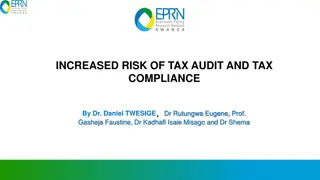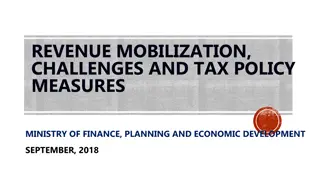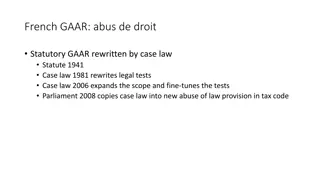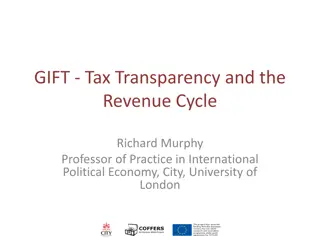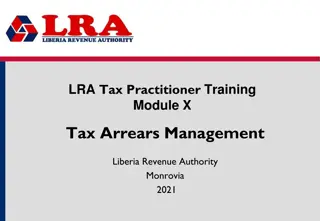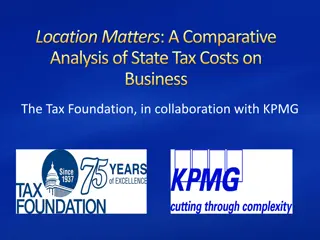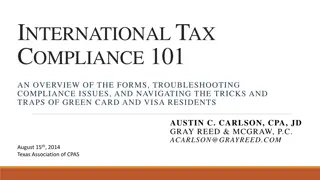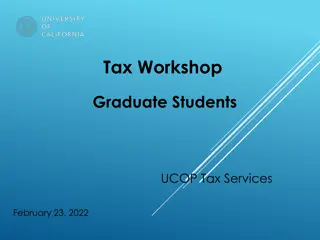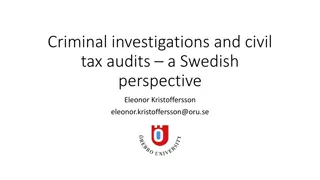Overview of Statutory & Tax Compliance: Practical Approach to IT Skills
Rule of law in democracy is crucial for protecting human rights, ensuring accountability, and maintaining social order. This presentation delves into the necessity and features of statutory and tax compliance, covering key concepts like registration, filing of returns, attestation functions, and more.
Download Presentation

Please find below an Image/Link to download the presentation.
The content on the website is provided AS IS for your information and personal use only. It may not be sold, licensed, or shared on other websites without obtaining consent from the author.If you encounter any issues during the download, it is possible that the publisher has removed the file from their server.
You are allowed to download the files provided on this website for personal or commercial use, subject to the condition that they are used lawfully. All files are the property of their respective owners.
The content on the website is provided AS IS for your information and personal use only. It may not be sold, licensed, or shared on other websites without obtaining consent from the author.
E N D
Presentation Transcript
E-LEARNING OVERVIEW OF STATUTORY & TAX COMPLIANCE Practical Approach to IT Skills
Introduction Introduction: Rule of law in democracy is essential for protecting human rights, promoting accountability and transparency, and maintaining social order and stability within a society, and to ensure that the legal system operates fairly and impartially for the benefit of all citizens. Statutory compliance is necessary to uphold the rule of law, protect public interests and to maintain trust and integrity in the legal environment.
Background Context : Term Legal Jurisprudence first coined by Sir John Austin in 1832. According to him Law is the command of sovereign who is an uncommendable superior human being, non-compliance which may visit physical punishment. This philosophy is known as legal positivism. Friedrich Carl von Savigny argued that law wasn't created by legislators or imposed from above. Instead, it emerged organically from the customs, traditions, and "Volksgeist" (spirit of the people) over time. This theory of law is known as the Historical School of Law . According to Oliver Wendell Holmes, Jr. Taxes are the cost of living in civilized society. All of the above legal philosophies tend to force legal compliance. Objective : This presentation aimed to focus on the necessity and features of statutory and tax compliance.
Key Concepts While statutory compliance is the duty of every citizen of India, it is adhered to by the legal professionals on behalf of the concerned citizen. To mitigate literacy it is advisable to have appropriate authority to act from the concerned person. Statutory compliance can be classified into following categories: Registration Filing of Returns Perform Attest Functions Reply notice / hearing and file appeal to the court PAN, TAN, EXIM, GST, Form Partnership, LLP, Trust, Society, Incorporate Companies ITR, TDS, GST, RERA, Audit, Certificate for compliance Submission of statutory proceedings
Key Concepts Registration / Modification / Cancellation of Registration under law: Every law provides Registration / Modification / Cancellation of Registration requirements under its enactment. Once registration is complete further compliance arises. For example, the requirement of a separate bank account in which subscription from the promoter is to be held and then to transfer that amount to the company's bank account and proceed for allotment procedure. Minor / Adult: In various statute registration / modification / cancellation can only be made if the applicant is not minor. Some statute requires completion of age of 21 instead of 18 if the applicant s guardians are not his parent / applicant is adopted. Registration of Registration number at web sites: If someone has PAN then he can not file his returns of income tax without complying with registration of PAN at Income Tax Website. Similarly Registration of TAN is required to be made at two websites one is at Income Tax and another is at TRACES. Verification Process: On a paper document a person can authorize that document by making a signature at document, but when information is processed by electronic mode the verification process is made by digital means.
Key Concepts Digital Signature: Digital signatures are physical USB devices used for verification. Computers on which such verification is to be made must be complied with other software or hardware requirements. GST, Income Tax, TDS and RoC required to have specific software utility like emsigner or gstesigner. These software require that JAVA Runtime Environment has to be installed for their functionality. Also these software may require to be run with administrator privilege. Some statute e.g. EPF may require that the registration of Digital Signature should further authenticate by way of intimation of digital signature registration on a paper application mode. In such a case if the applicant is a company / LLP / partnership firm / trust then separate authority is required to be filed.
Key Concepts Filing of Returns / Audit Report / Certificate / Other Applications: This includes submission of furnishing of financial or non financial data with the government authority at monthly / quarterly or annually. Non financial data may include addition / deletion of members of epf / esic, intimation of adoption / rejection of statutory facility e.g. adopt composition scheme or to get out of composition scheme etc. In all cases information must be authorized by the assessee and there should not have / bear any discrepancy in information and supporting documents. In case of payment of contribution, stamp, any other duty, tax, interest or levy, such payment must be made by authorized manner and evidence of such payment must exist before filing return. The software that prepares data for filing must follow the requirement. Third party software should be updated to the latest as of date.
E-PAN Every person who has Aadhaar can apply to E-PAN at income tax India website. This is a process wherein details of the person as given in the Aadhaar is taken as it is for PAN registration. Mr. Ram Kumar, an IIT student, got a job through a campus placement programme at ABC Ltd., an IT company. ABC Ltd. asked Mr. Ram to submit his PAN card to meet statutory compliance. Since Mr. Ram does not have a PAN card, he approached you to take an instant E-PAN with the following details In this scenario, Mr. Ram Kumar need to log in to the website of income tax department and follow the below mentioned process Online Application: Mr. Ram Kumar should go to the Income Tax Department's official e-filing website and select the "Apply Instant e- PAN" option. (https://eportal.incometax.gov.in/iec/foservices/#/pre-login/instant-e-pan) Submission of Form: The individual completed the digital application form, furnishing pertinent particulars including his Aadhaar card number, complete name, date of birth, and contact details. Aadhaar authentication: subsequent to the submission of the form, during which his biometric and demographic information were validated in comparison to the Aadhaar database. Confirmation and Grant of Approval: The Income Tax Department promptly processed Mr. Ram Kumar s application following successful authentication. His registered email address was credited with the e-PAN PDF that was utilized to generate his digital PAN card.
ITR/PAN Registration Before filing a return with the income tax website every assessee is required to get registered at income tax portal for one time only (generally known as creating login ID at income tax). The PAN of the person is a login ID and he needs to create a password, set email and mobile number. Status of return, refund, demand, filing of belated or updated return can only be made after creating login at income tax portal. Generally, there are five phases involved in the registration process for an Income Tax Return (ITR): 1. Collect the Necessary Paperwork: Gather the required paperwork, including Aadhaar card, PAN card, bank account information, and evidence of source of income. 2. Go to the website of the Income Tax Department: Visit the Income Tax Department's official website or the online gateway meant for ITR registration. 3. Complete the Registration Form: Provide accurate personal and financial information on the registration form, such as PAN, Aadhaar, bank account information, and contact data. 4. Upload the completed registration form and any necessary supporting papers to complete the submission process. Make sure all of the information is correct and current. 5. Get Registration Confirmation: user will get an ITR registration confirmation if his submission is successful. Additionally, he can get notifications or other instructions about the next process.
ITR1 Filing Income tax return filing is required to select the appropriate return type. These return types are known by numbers or words like ITR-1, ITR-2 or by ITR-U. This classification is made on the basis of source of income being reported in income tax return or the category of assessee who is or on behalf of whom income tax return is being filed. ITR 1 can be filed if the assessee is a resident in India, having sources of income from salary, one house property, interest and family pension and such income does not exceed Rs. 50 lakh.
Tax software and utilities Return filing in electronic form can be made by two ways; (1) prepare data in specific format and upload / save that data on tax websites. After validation, the website asks for verification and thereafter return filing completed. (2) enter data on the website and make verification to complete the return filing process. In the first case third party software or tools available for preparing data in requisite format. Third party software have internal checks to remove redundancy or errors or incompleteness. Some software or utilities are also provided by tax management bodies for small taxpayers, like tax preparation tools by GST, ITR utilities by the Income Tax Department, TDS Return Preparation Utility by NSDL etc.
GST Compliance Goods and Service Tax compliance include registration under GST, submission of periodic returns, response to notice, enquiry and change / modification in registration detail. Similar to income tax, assessee is required to create a login ID and password at the GST website. After submission a temporary transaction reference number is generated which becomes final after verification by the assessee.
GST Registration Information for Registration Business / Trade Name Proprietor s Name (As per PAN) Partner / Director / Trustee / Designated Authority Aadhaar of concern Individuals Mobile No. / Contact No. of Business Mobile No. / Contact No. of Individuals Place of Business Business Proof No Objection from Property Owner
GST Registration Create User ID and Generate Transaction Reference Number Await from departmental enquiry Reply enquiry / objection Proceed to Appellate authorities Download registration certificate
GST Returns Sr. No. Return Name Due Date Description thof Next Month thof the Month following of 1 GSTR 1 11 13 Quarter Return of Outward Supply. Mandatory Information includes: Inter-State Supply, Intra- State Supply, Export / SEZ Supply, Supply made by E Commerce Operators (Amazon, Flipkart), Documents and HSN Code. thof Next Month 2 GSTR 3B 20 Summary return of GST Liability. Mandatory Information includes: RCM Liability, Input Tax Credit eligible / in-eligible, URD Inter-state Supply, Exempt, NIL and Non-GST Inward Supply, Interest and Late Fee stDec of the year following 3 GSTR 9 31 relevant financial year Details and aggregate of details of GSTR1 and GSTR3B including HSN of Input Tax Credit if Input is 10% or more. 4 GSTR 2A No Filing Dynamic return of Input Tax Credit 5 GSTR 2B No Filing Monthly return for eligible Input Tax Credit
Employees Provident Fund Registration under EPFO Minimum no. of employees, approval of commissioner in case of no. of employees falls short of minimum no. Wage Limit for EPFO Contribution Universal Account Number of employees Filing of monthly contribution / supplementary contribution EPFO Challan Pre mature withdrawal / Partial withdrawal Final Withdrawal Pension
Employees State Insurance Corporation Registration under ESIC Minimum no. of employees Wage Limit for ESI Contribution I P Number of employees Filing of monthly contribution / supplementary contribution ESIC Challan Intimation of accident / claim by IP Treatment under government scheme (Ayushman Bharat) Family members of Insured person
Digital Signature DSC Registration involves acquiring an electronic identity proof from trusted Certifying Authorities (CAs) to ensure secure online transactions and document signing, validating identity and ensuring data integrity. Real-world applications of DSCs are diverse: they're used in government services for tax filing and e-tendering, in the corporate sector for signing digital documents, by legal professionals for digitally signing court documents, in financial transactions for secure online banking, and in e-commerce for validating the identity of sellers and buyers. Overall, DSC Registration plays a crucial role in enabling secure and legally valid digital interactions, enhancing trust and reliability in various domains. Timestamping: The process of associating a digital signature or digital certificate with a precise timestamp to establish the temporal authenticity and validity of electronic transactions or documents. Timestamping services ensure that digital signatures remain legally binding even after the expiration of associated digital certificates.
Digital Signature Token Driver JAVA / other supportive software API / EmSigner
Import Export Code Obtaining registration for Importer Exporter Code (IEC) is a straightforward process facilitated by the Directorate General of Foreign Trade (DGFT). Applicants need to fill out the online application form on the DGFT website, providing necessary details such as PAN, address proof, bank details, and business information. Upon submission, a fee payment is required, typically done online. After verification of the application and documents, the DGFT issues the IEC electronically. The entire process is relatively quick, taking a few days to a couple of weeks, depending on the completeness of the application and the processing time at the DGFT. Once obtained, the IEC serves as a unique identification number for businesses engaged in import and export activities, essential for customs clearance, documentation, and conducting international trade transactions.
Micro Small and Medium Enterprise Micro Small and Medium Enterprises Development Act, 2006 Enterprise: Manufacture of Goods, Provider of Service, First Schedule of Industrial (Development and Regulation) Act, 1951 Goods: Immovable property, actionable claim and money not included. Definition of Small, Medium and Micro Enterprise under section 7 of the MSMED Act, 2006 Udyam registration: https://udyamregistration.gov.in/
Udyam Registration UID of entrepreneur Name, PAN, GST no. if any, ITR Filing status, Contact No. and Email ID Ownership / Sharing % by OBC/SC/ST and women Name and address / location of Enterprise, Unit Bank account detail NIC Code No and category of employees District Industries Centre detail
MCA filings Companies and LLP require to comply with relevant statute by way of MCA filings. MCA filings are categories in two versions, version 2 and version 3. In version 2 pdf forms are available on the MCA website. Users are required to download the pdf file as required, fill data into the pdf file, attach required documents in pdf format, affix digital signature and thereafter upload the pdf file at MCA portal. In version 3 all forms are web based filling type, Users are required to fill online and save the form. After completion of filling a validation is made and form available for download. User needs to download the form, affix a digital signature and upload the form. In both cases payment is made after uploading the forms and thereafter an email showing the status of filing is sent by the department. MCA is keen to transfer from v2 to v3. Apart from this changes in information in relevant filing is also changed.
TDS and TCS Acquire TAN TDS without TAN in case of Sale of Property Registration of TAN at Income Tax Site Registration of TAN at Traces website Statutory provisions governing TDS and TCS transactions under the Income Tax Act, 1961 Challan Payment Return preparation CSI File FVU File FVU Utility by NSDL Upload Return Generate TDS / TCS Certificate Modification in TDS / TCS Detail or Challan Information Default in TDS / TCS and Rectification of Default
Case Studies What is evidence of payment: Income Tax paid and the payment is deducted from the bank account however challan is not generated. Can the bank statement only function as evidence of payment if the amount is debited / deducted from the bank account. GST paid and challan of GST Paid is available. Amount of GST is also shown in Cash Ledger. At the E-Pay Challan of ESIC website, a message is appearing: No online Challan pending for the employer!
Solution or Recommendation Proposed Solutions: Every payment is required to be made in such a manner so that the person paying the amount becomes entitled for credit of such payment from his tax liability. Case (1) If PAN / TAN is not mentioned correctly the bank statement will show debit of amount but the payment is not entitle to assessee to claim set of his tax liability. Case (2) GST challan is evidence of transfer of money to cash ledger. During GSTR3B when set off of liability completed then such set off becomes evidence of payment. Case (3) The message that No online challan pending for the employer. may be revealed if contribution for the latter period is not filed. However if challan for the last month of till date are filed then only this message serves the apprehension for payment of tax till date.
Case Studies Sunil Chethan is running a sole proprietorship named Order on Wheels, which is a food delivery app operating in Bengaluru, Karnataka, India. Sunil is planning to register his business under the Companies Act. To complete the registration process, he needs a Digital Signature Certificate (DSC). Here in the scenario we need to just login to the E-mudra portal with credentials we have obtained and after that the details of the particular person needs to be entered in the portal. After verifying the E-mail, mobile and ADHAAR the entire DSC registration can be completed. Once after applying next thing is video verification from the part of person whom the particular DSC is applied.
Case Studies XYZ Trading Co, an Indian exporter specializing in handcrafted goods wants to expand its business to international markets. They acquired an order from Azerbaijan based company. They presently cant do the trade as they have no IEC and it is mandatory in to have IEC for import/export. What should be done from XYZ trading co to tackle this obstacle. In this scenario, In order to tackle this obstacle, they should start the IEC registration process in the DGFT (Directorate General of Foreign Trade). After logging into the DGFT portal they should carefully compile the necessary documents required by the portal and submit the same for successful registration. IEC grants them the authorization to engage in export/import activities. This results in increased market penetration, heightened competitiveness, and enhanced operational effectiveness via the implementation of compliance training and streamlined processes. By establishing an IEC, XYZ Trading Co is able to expand its customer base, obtain entry into international markets, and compete more fairly with rivals. In general, the procurement of an IEC facilitated XYZ Trading Co.'s access to expansion prospects, adherence to regulatory requirements, and prosperity in the international market.
Case Studies Rajesh Kumar is an individual with income from multiple sources that surpasses the basic exemption limit. Therefore, he needs to register with the income tax department. By registering on the e-Filing portal, he will gain access to various functionalities and tax-related services provided by the portal. Rajesh has provided you with the necessary information. As a tax practitioner, advise him to proceed with the registration under income tax. Here in this scenario, All the details such as PAN, ADHAAR & Address of Rajesh Kumar can be filled in the ITR website and validate the mobile and E-mail and can complete the registration process. By this that particular person will be able to take ITR registration and further returns can be filed with those credentials obtained.
Case Studies "ABC Corporation, a mid-sized manufacturer in India, faced challenges in efficiently overseeing its corporate governance protocols. Compliance delays and additional administrative burdens were incurred by the management team due to the manual submission of documents and bureaucratic constraints. As a result, ABC Corporation made the decision to employ the services that were made available via the MCA21 initiative. As part of this ABC Corporation was required to make a designation change for one of its directors and subsequently complete the necessary filings." In this scenario, ABC Corporation should access the e-filing services of MCA21 and proceed to file a DIR12 form to intimate the change in designation of the particular director with the necessary documents required by the portal.
Future Outlook Future Trends: All statutory compliance in which reporting or communication with public authority is required done by computers or somehow they include use of technology. In this limited sense rapid pace of technical advancement and unforeseen breakthrough encompasses through statutory compliance also. Long-Term Implications: In the current scenario non-living objects can recognize human gestures. Humans can interact with the machine in natural language. Extended Reality (virtual reality + augmented reality) impacting gaming, education and remote collaboration. It is expected that complex problems can be solved by quantum computing. New computing paradigms have potential trends by way of Bio- Inspired Computing. Statutory compliance will merge with the technology as far as they relate to human comfort except culture and tradition.
Conclusion Summary: The obligation of individuals and organizations to comply with the laws, rules, and regulations set forth by the government. In India, every citizen is responsible for ensuring that they follow these statutory requirements. Use of technology in statutory compliance enhances organizations' ability to meet regulatory requirements, reduce compliance costs, and mitigate compliance risks in an increasingly complex regulatory environment.
THANK YOU
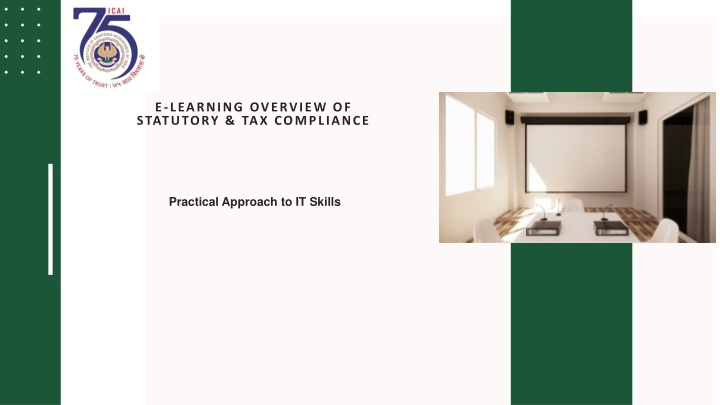


![Town of [Town Name] Real Estate Tax Rates and FY 2024 Budget Summary](/thumb/62211/town-of-town-name-real-estate-tax-rates-and-fy-2024-budget-summary.jpg)
